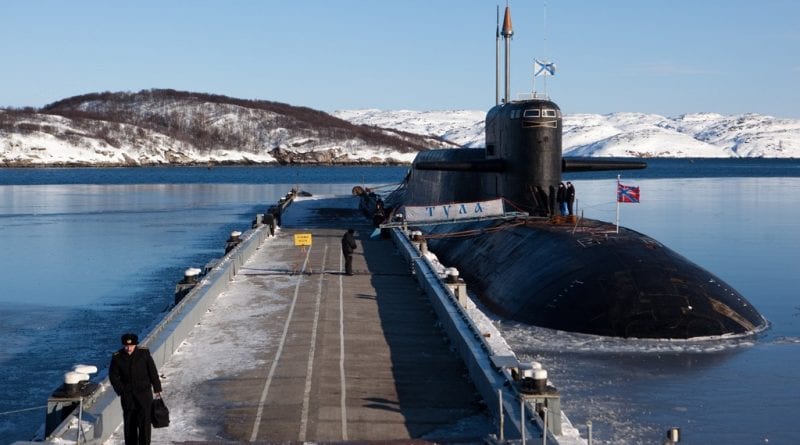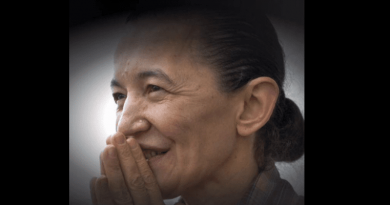SIGNS: THE RISE OF RUSSIAN NUCLEAR ORTHODOXY… Christian temples installed onto Russian Nuclear submarines and naval vessels
“Yet he convincingly depicts the lengths to which the military has gone to accommodate this nuclear priesthood, from field churches for the strategic missile force to underwater churches in ballistic nuclear submarines. More than 40 such churches exist across the Russian Navy alone. Still, the church’s influence on and relevance to unit operations debatable, as this military analyst had difficulty envisioning the role religion plays in command relationships beyond providing spiritual support for the force.
Dmitry Adamsky, Russian Nuclear Orthodoxy: Religion, Politics, and Strategy (Stanford University Press, 2019).
Russia’s Federal Nuclear Center, the All-Russian Institute of Experimental Physics (RFNC-VNIIEF), recently placed a somewhat unusual government tender: It is seeking a supplier of religious icons with the images of Saint Seraphim of Sarov and Saint Fedor Ushakov. Meanwhile, a private foundation, backed by President Vladimir Putin and Minister of Defense Sergei Shoigu, has been gathering funds to build a massive temple to the Russian Armed Forces at Patriot Park,. Artisans are crafting a new icon for the temple, while the steps are to be made from melted-down Nazi equipment captured by the Red Army in World War II.
Viewed in isolation, these may seem to be the occasional eccentric habits of a latter-day authoritarian state. However, Dima Adamsky’s new book, Russian Nuclear Orthodoxy: Religion, Politics, and Strategy, demonstrates convincingly that there are indeed important signs being missed all around us, pointing to a longstanding nexus between the Russian Orthodox Church and the country’s nuclear-military-industrial complex.
Adamsky’s groundbreaking book lays out the largely unstudied history of how a nuclear priesthood emerged in Russia, permeated the units and commands in charge of Russia’s nuclear forces, and became an integral part of the nuclear weapons industry. Starting with the Soviet Union’s dissolution in 1991, through a process Adamsky frames as “genesis, conversion, and operationalization,” the Russian Orthodox Church positioned itself “as one of the main guardians of the state’s nuclear potential and, as such, claims the role of one of the main guarantors of Russian nuclear security.” At first the church partnered with the military, enabling servicemen to fulfill their religious obligations while on duty. In time, religion penetrated more deeply into the military, as Russia’s political elite and religious elite intertwined. Today, the church has entrenched itself at the tactical and operational levels of the Russian nuclear forces. Depending on how one views the role of religion in the context of nuclear forces, that’s either a discomforting or a comforting thought.
Adamsky’s book covers two distinct but equally fascinating processes that have taken place in post-Soviet Russia: the church’s integration into the nuclear-military complex and the political system’s parallel quest to engineer a national idea, lend itself legitimacy, and rebuild the power of the state that crumbled when the Soviet Union collapsed. Russian Orthodoxy is thus a decidedly secular concept, a mechanical replacement part for the many bits of machinery – or in Russian parlance “political technology” – that broke during the nation’s failed attempt at democracy in the 1990s. The church, an institution with ambitions of its own, volunteered to participate in Russia’s time-honored tradition of restoring state power after collapse, and expanding it to dominate society. At its heart, Russian nuclear orthodoxy constitutes the collective belief that to preserve its Orthodox character, Russia must be a nuclear power, and to guarantee its nuclear status, Russia must be genuinely Orthodox.
Adamsky’s findings have relevance for other longstanding debates, such as the question of whether the system crafted under Vladimir Putin will outlast its creator. Russian Nuclear Orthodoxy suggests that the country’s political system is more than just an assemblage of patronage networks, court intrigue, national security clans, and elite corruption. It is engaged in a political project whose mission is to create state power, legitimate it, and wield it for as long as possible. The military has similarly looked to the church to restore a culture of conservative values, nationalism, and a political commissariat that once existed under the Soviet Union. This, however, may be the reviewer’s cynical interpretation based on his own experience with the subject matter. Adamsky walks gingerly through this minefield of Russia studies, seeking to substantiate his thesis of integration, conversion, and operationalization of the Russian Orthodox Church into Russian nuclear forces.
The emergence of Russia’s religious-nuclear nexus is a classic tale of elite instrumentalism, political alliances of convenience, and earnestly held belief. The contradictions do not negate each other, a familiar state of affairs for those who study Russia. In Adamsky’s “genesis” phase, the Russian Orthodox Church resurrects itself from the ashes of Soviet collapse by allying with a defunct and demoralized Russian military. The head of the church portrays his institution and the military as “brothers in arms.” According to Patriarch Metropolitan Kirill, both institutions had been excluded from political life and had a commitment to self-sacrifice. Thus the church would prove to be “the strongest ally of the military when it came to justifying its mission in the eyes of Russian society.” Adamsky traces the origins of the religious-nuclear nexus to Arzamas-16 (the city also known as Sarov), the birthplace of both the Soviet nuclear weapons program and Russia’s revered saint, Seraphim of Sarov. Facing a doubtful future, neglected by officialdom, the nuclear weapons industry seized the opportunity to make an ally in an Orthodox church seeking to restore its own position.
Though seemingly a marriage of convenience, the Russian Orthodox Church appears strategic in its efforts to ally with the nuclear complex. Strategic mythmaking lies at the heart of this union. At the tide of communism receded, the church sought to reclaim its place in Russian life. One can imagine the Russian Orthodox Church, like many faiths before it, seeking to appropriate the monuments and temples left behind by the communist system, which worshiped at the altar of technological progress. There was perhaps no stronger symbol of the achievement of the Soviet system than the country’s awesome nuclear arsenal, which underpinned its status as a great power in the international system.
In the 1990s, Russia’s strategic nuclear forces were still the best-funded segment of the military, but the service was demoralized, having lost the sense of mission offered by the Cold War. Russia may have cut defense spending to the bone, but it would always find money for the nuclear deterrent, seen as the sole guarantor of its status and sovereignty. It may have been not serendipity, but in fact strategy, that led Patriarch Alexy II to bid for the soul of Russia’s nuclear-military complex in 1991. Thus, a myth was born advocating the “divine predestination of the Soviet nuclear project” at the religious site of Sarov, as the Russian Orthodox Church and the RFNC-VNIIEF seemingly adopted each other. Though the author rightly titles this tale as genesis, it would be no less appropriate to characterize the process as one of mutual adoption and, subsequently, twin resurrection. In a sense, the church reconsecrated the Soviet-built nuclear military complex as its own progeny.
Adamsky shows how the church ascended Russia’s power structures to become a pillar of the political regime. Yet there is an inherent tension between the Kremlin’s needs and those of the church. The church wanted to be an ally of the regime without becoming a mere puppet of the political leadership . However, whereas Putin defines the Russian state as multi-confessional, Kirill sees the Orthodox church as having privileged status, calling it an “Orthodox country with national and religious minorities.” This divide proves problematic for a ruling system seeking to appropriate the church instrumentally while also managing a country that is far more religiously heterogeneous than the church cares to admit.BECOME A MEMBER
It’s unclear how the state squares the circle of a multi-confessional state identity, composed of Orthodox Christians, Muslims, Jews and Buddhists, with the Russian Orthodox Church’s desire for privileged status. This in a country where Islam is a rapidly growing religion and millions of workers from Central Asia labor in the cities. Adamsky shows that while most Russians today consider themselves to be Orthodox, much more so than during the 1990s, the majority are non-practicing, or “believing without belonging.” The book reveals a paradox: Even while Russia has become much more Orthodox, as Ekaterina Schulmann poignantly observed in a recent lecture, it is a largely urbanized, secular, and highly educated society. Russian Orthodoxy therefore appears less a religion and more a secular construct of conservative values and traditional ideals, installed by the state as a replacement part for the function once performed by communism. As Adamsky explores the “operationalization” period of state-church relations, it increasingly appears that while the Russian Orthodox Church is a religious institution, as operationalized, Russian Orthodoxy is not a religion but an element of state ideology and a markedly secular one at that.
The book offers several perspectives on how to conceptualize the nature of the church-Kremlin arrangement, from a symphony of equals, to jointly managed democracy, to a clear-cut asymmetry in which Putin has primacy over Kirill. The author demurs from explicitly advocating any of these perspectives, leaving the reader to draw their own conclusions. Is it a vertical power structure run by Putin, or perhaps more a court-like system, shaped by competing informal patronage networks, clans, and organizational rivalries, where the leader arbitrates and decides on those issues where he takes actual interest?
Perhaps no leader better illustrates the importance of Adamsky’s thesis than Putin himself, who in October 2018 used noticeably religious framing to discuss what would happen if Russia were to be attacked by a nuclear first strike. He proclaimed, “An aggressor should know that vengeance is inevitable, that he will be annihilated. Whereas we would become the victims of their aggression, and as martyrs, will go to heaven – they will just end up dead,” adding to clarify for the audience, “because they won’t even have time to repent.” Given this language, it is perhaps not surprising that according to Adamsky, today “each leg of the nuclear triad has its patron saint,” and “icons appear on the nuclear platforms, while ” aerial, naval, and ground processions of the cross are routine.”
Putin’s personal beliefs are worth scrutinizing, though what passes for Kremlinology can at times devolve into amateur Freudian psychoanalysis. The book plays with the subject of whether Putin is truly religious, or whether his interaction with the church is pragmatic, intended to establish it as a pillar of Russian nationalism as part of his construct for the national idea. Adamsky is cautious here, suggesting that Putin’s religious beliefs are to a certain extent genuine, but he still leaves readers wondering whether the influence of religion on Russian domestic and foreign policy is a result of some authentic belief or a managerial solution for the Kremlin’s “political technologists.” The likelier, but more vexing, answer is that it is both.
For the Russian military, the institutional – as opposed to theological – role of religion seems straightforward . Orthodoxy for the armed forces is not an ecclesiastical discourse; rather, it’s an instrument to inoculate the military against Western influence, psychological warfare, and perceived efforts at political subversion. Today, the church is seen as a vehicle to build resilience within the force, increasing morale, unit cohesion, and sense of mission, while advocating for conservative values. The clearest example of this thinking is the General Staff’s decision in 2018 to establish the Main Directorate for Political-Military Affairs (GVPU), appointing the former head of the Western Military District, Andrey Kartapalov, as its first chief. This newly created organization harkens back to the Soviet Union’s Main Military-Political Directorate (GlavPUR), which had similar functions during communist times. Again, the system appears to be using the church to craft replacement parts for institutions it once had based on a political ideology that has been lost.
Col. Gen. Kartapalov was a logical choice for the post given his published thoughts on the subject of Western indirect approaches, described as “hybrid warfare.” In a 2015 speech, he presented views on how the West uses indirect actions to engage in what the Russian military terms “New-Type Warfare,” including “disorienting the political and military leadership of the state-victim” and “pressuring the enemy politically, economically, informationally, and psychologically.”The GVPU will providepsychological support, improve the moral state of servicemen, organize state-patriotic education, and the like. Russia’s General Staff sees the Orthodox church as one element of a strategy to bolster resilience in the information-psychological domain, cordoning off the Russian armed forces from U.S. indirect approaches or perceived efforts to distance the military from its own population.
At first glance, Adamsky’s argument that Orthodox priests also function within the Russian nuclear forces at the tactical level – in addition to the ideological – seems to be a bit of overreach. Yet he convincingly depicts the lengths to which the military has gone to accommodate this nuclear priesthood, from field churches for the strategic missile force to underwater temples in ballistic nuclear submarines. More than 40 such temples exist across the Russian Navy alone. Still, the church’s influence on and relevance to unit operations debatable, as this military analyst had difficulty envisioning the role religion plays in command relationships beyond providing spiritual support for the force.
Questions abound. Could the integration of the Russian Orthodox Church with the nuclear force bolster the country’s coercive credibility by improving an adversary’s perception of its resolve? If so, then to paraphrase Dr. Strangelove, the whole point will be lost if they keep it a secret. How should we perceive the church’s influence on unit cohesion and decision-making at lower echelons? Can the church inspire units to ensure execution of their mission? Are priests able to deploy with nuclear forces during war?
Physically, such accommodations are unlikely to be made in a strategic bomber or road-mobile intercontinental ballistic missile unit, though does show that temples exist aboard ships and submarines. There is reason to be skeptical of the Russian Orthodox Church’s role during a threatened or initial period of war, once units depart their initial bases to deployment zones and staging areas. Given the secrecy involved and the logistical constraints, it somewhat stretches the imagination to picture priests forward deploying with disparate missile units. Then again, anything is possible in Russia, a country that built an automated nuclear response system. One wonders, does the Dead Hand have a dedicated priest of its own, or given the construct was originally Soviet, can we assume the automated second-strike machine is an atheist?
It may be reassuring to picture this nuclear-religious nexus as a passing phase, and indeed, several of the Russian analysts Adamsky interviews suggest as much, perhaps seeking to dismiss an uncomfortable reality. However, the church’s conversion into a pillar of state ideology and the military’s doctrinal acceptance of the organization’s utility offer good evidence that both the nuclear priesthood and the broader doctrine of nuclear orthodoxy will outlast the current regime. Hence Adamsky ends up exploring two enduring processes: the integration of the church as a religious organization into the Russian nuclear-military complex, and the state’s adaptation of Orthodoxy as a secular concept that serves its own vision for the national idea, working to fill the ideological void left by communist ideology.
Reading Adamsky’s book, I recalled Nietzsche’s observation about the impact of science and technology on faith: “God is dead. God remains dead. And we have killed him.” Looking at Russia, this may seem true at first, but as Adamsky shows, the Russian Orthodox Church – and Russian nuclear orthodoxy – are very much alive, and here to stay.BECOME A MEMBER
Michael Kofman is a Senior Research Scientist at CNA Corporation and a Fellow at the Wilson Center’s Kennan Institute. Previously he served as program manager at National Defense University. The views expressed here are his own.





